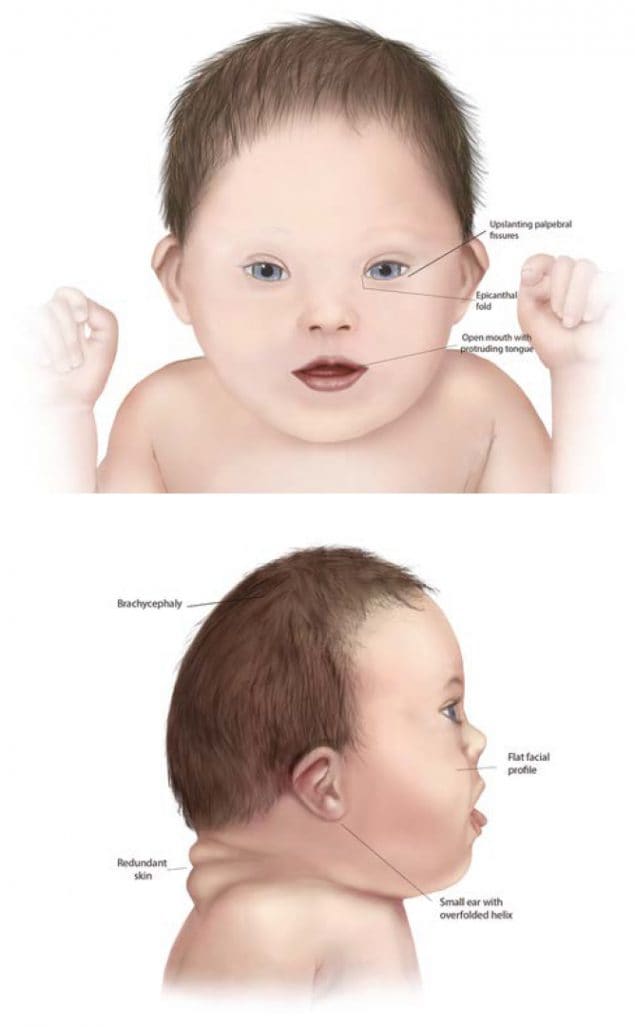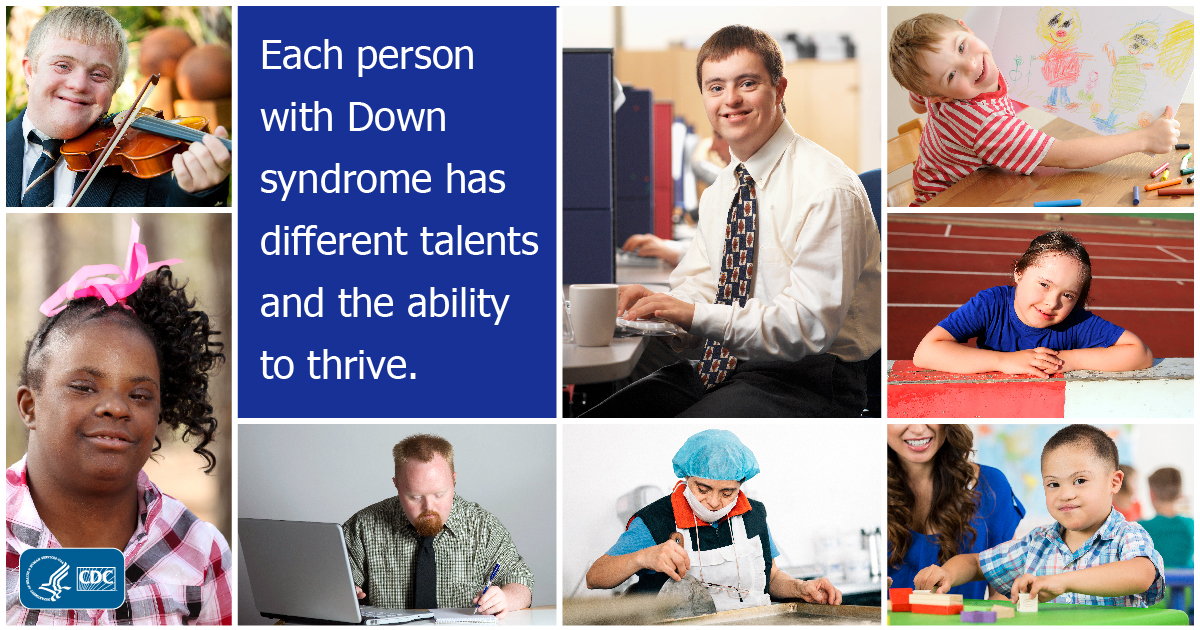What Is the Likelihood of Down Syndrome in Baby
Down syndrome is a status in which a person has an actress chromosome.

What is Down Syndrome?
Down syndrome is a condition in which a person has an extra chromosome. Chromosomes are small "packages" of genes in the torso. They determine how a babe's body forms and functions as it grows during pregnancy and subsequently birth. Typically, a baby is born with 46 chromosomes. Babies with Down syndrome have an extra copy of one of these chromosomes, chromosome 21. A medical term for having an extra copy of a chromosome is 'trisomy.' Downwardly syndrome is also referred to as Trisomy 21. This extra copy changes how the baby's body and brain develop, which can cause both mental and physical challenges for the infant.
Even though people with Down syndrome might act and look similar, each person has different abilities. People with Down's syndrome ordinarily have an IQ (a mensurate of intelligence) in the mildly-to-moderately low range and are slower to speak than other children.
Some mutual physical features of Down's syndrome include:
- A flattened face up, specially the bridge of the nose
- Almond-shaped optics that slant up
- A brusque cervix
- Small ears
- A natural language that tends to stick out of the oral fissure
- Tiny white spots on the iris (colored part) of the center
- Small hands and feet
- A single line beyond the palm of the hand (palmar pucker)
- Minor pinky fingers that sometimes curve toward the pollex
- Poor muscle tone or loose joints
- Shorter in height as children and adults
How Many Babies are Born with Down syndrome?
Down syndrome remains the most mutual chromosomal status diagnosed in the United States. Each yr, about 6,000 babies born in the United States have Downward syndrome. This ways that Down syndrome occurs in nearly one in every 700 babies.1
Types of Down Syndrome
There are three types of Down syndrome. People often can't tell the divergence betwixt each type without looking at the chromosomes because the physical features and behaviors are similar.
- Trisomy 21: About 95% of people with Down's syndrome have Trisomy 21.2 With this type of Down syndrome, each prison cell in the torso has 3 separate copies of chromosome 21 instead of the usual 2 copies.
- Translocation Down syndrome: This type accounts for a minor percentage of people with Down's syndrome (virtually three%).ii This occurs when an extra role or a whole extra chromosome 21 is present, but information technology is attached or "trans-located" to a dissimilar chromosome rather than being a separate chromosome 21.
- Mosaic Down syndrome: This type affects almost ii% of the people with Down syndrome.ii Mosaic means mixture or combination. For children with mosaic Down syndrome, some of their cells have 3 copies of chromosome 21, simply other cells have the typical two copies of chromosome 21. Children with mosaic Down syndrome may have the same features as other children with Down's syndrome. Nonetheless, they may have fewer features of the condition due to the presence of some (or many) cells with a typical number of chromosomes.
Causes and Hazard Factors
- The extra chromosome 21 leads to the physical features and developmental challenges that can occur among people with Down syndrome. Researchers know that Down syndrome is acquired by an extra chromosome, but no one knows for certain why Downwards syndrome occurs or how many unlike factors play a role.
- One factor that increases the adventure for having a babe with Down syndrome is the mother's age. Women who are 35 years or older when they become pregnant are more than likely to take a pregnancy affected by Down syndrome than women who become pregnant at a younger historic period.iii-5Nonetheless, the bulk of babies with Downwardly syndrome are built-in to mothers less than 35 years former, because there are many more than births amid younger women.6,7
Diagnosis
In that location are two basic types of tests available to detect Down's syndrome during pregnancy: screening tests and diagnostic tests. A screening test can tell a adult female and her healthcare provider whether her pregnancy has a lower or higher chance of having Down syndrome. Screening tests do non provide an absolute diagnosis, but they are safer for the mother and the developing baby. Diagnostic tests can typically observe whether or not a babe will have Down's syndrome, but they tin be more risky for the mother and developing baby. Neither screening nor diagnostic tests can predict the total impact of Down's syndrome on a baby; no 1 tin can predict this.
Screening Tests
Screening tests often include a combination of a blood examination, which measures the corporeality of diverse substances in the female parent's blood (east.g., MS-AFP, Triple Screen, Quad-screen), and an ultrasound, which creates a moving-picture show of the baby. During an ultrasound, 1 of the things the technician looks at is the fluid behind the baby's cervix. Actress fluid in this region could indicate a genetic problem. These screening tests can help make up one's mind the baby's risk of Downward syndrome. Rarely, screening tests tin requite an abnormal outcome fifty-fifty when in that location is cipher incorrect with the baby. Sometimes, the examination results are normal and yet they miss a problem that does exist.
Diagnostic Tests
Diagnostic tests are usually performed after a positive screening test in guild to confirm a Downwards syndrome diagnosis. Types of diagnostic tests include:
- Chorionic villus sampling (CVS)—examines material from the placenta
- Amniocentesis—examines the amniotic fluid (the fluid from the sac surrounding the baby)
- Percutaneous umbilical blood sampling (PUBS)—examines blood from the umbilical string
These tests look for changes in the chromosomes that would indicate a Down syndrome diagnosis.
Other Health Bug
Many people with Down syndrome take the common facial features and no other major birth defects. However, some people with Down syndrome might have one or more major nativity defects or other medical problems. Some of the more mutual health problems amongst children with Downwards syndrome are listed below.viii
- Hearing loss
- Obstructive slumber apnea, which is a condition where the person's breathing temporarily stops while asleep
- Ear infections
- Eye diseases
- Middle defects present at birth
Health care providers routinely monitor children with Down's syndrome for these atmospheric condition.
Treatments
Down syndrome is a lifelong condition. Services early in life will oftentimes assistance babies and children with Down syndrome to better their concrete and intellectual abilities. Most of these services focus on helping children with Down's syndrome develop to their full potential. These services include speech, occupational, and concrete therapy, and they are typically offered through early intervention programs in each state. Children with Down's syndrome may also need extra help or attending in school, although many children are included in regular classes.

Other Resources
The views of these organizations are their own and do not reverberate the official position of CDC.
- Down's syndrome Research Foundation (DSRF)external icon
DSRF initiates inquiry studies to better empathize the learning styles of those with Downward syndrome. - Global Down's syndrome Foundationexternal icon
This foundation is dedicated to significantly improving the lives of people with Down syndrome through research, medical care, teaching and advocacy. - National Clan for Down Syndromeexternal icon
The National Clan for Down Syndrome supports all persons with Down syndrome in achieving their full potential. They seek to help families, educate the public, address social issues and challenges, and facilitate agile participation. - National Down Syndrome Society (NDSS)external icon
NDSS seeks to increase awareness and credence of those with Down syndrome.
References
- Mai CT, Isenburg JL, Canfield MA, Meyer RE, Correa A, Alverson CJ, Lupo PJ, Riehle‐Colarusso T, Cho SJ, Aggarwal D, Kirby RS. National population‐based estimates for major birth defects, 2010–2014. Birth Defects Research. 2019; 111(18): 1420-1435.
- Shin Thousand, Siffel C, Correa A. Survival of children with mosaic Down syndrome. Am J Med Genet A. 2010;152A:800-1.
- Allen EG, Freeman SB, Druschel C, et al. Maternal age and chance for trisomy 21 assessed by the origin of chromosome nondisjunction: a written report from the Atlanta and National Downwardly Syndrome Projects. Hum Genet. 2009 Feb;125(one):41-52.
- Ghosh S, Feingold E, Dey SK. Etiology of Downward syndrome: Evidence for consistent clan among altered meiotic recombination, nondisjunction, and maternal age beyond populations. Am J Med Genet A. 2009 Jul;149A(7):1415-twenty.
- Sherman SL, Allen EG, Edible bean LH, Freeman SB. Epidemiology of Down syndrome. Ment Retard Dev Disabil Res Rev. 2007;13(iii):221-7.
- Adams MM, Erickson JD, Layde PM, Oakley GP. Down syndrome. Recent trends in the United States. JAMA. 1981 Aug 14;246(7):758-sixty.
- Olsen CL, Cross PK, Gensburg LJ, Hughes JP. The furnishings of prenatal diagnosis, population ageing, and changing fertility rates on the live birth prevalence of Down syndrome in New York State, 1983-1992. Prenat Diagn. 1996 Nov;sixteen(11):991-1002.
- Balderdash MJ, the Commission on Genetics. Health supervision for children with Down syndrome. Pediatrics. 2011;128:393-406.
Source: https://www.cdc.gov/ncbddd/birthdefects/downsyndrome.html
Post a Comment for "What Is the Likelihood of Down Syndrome in Baby"